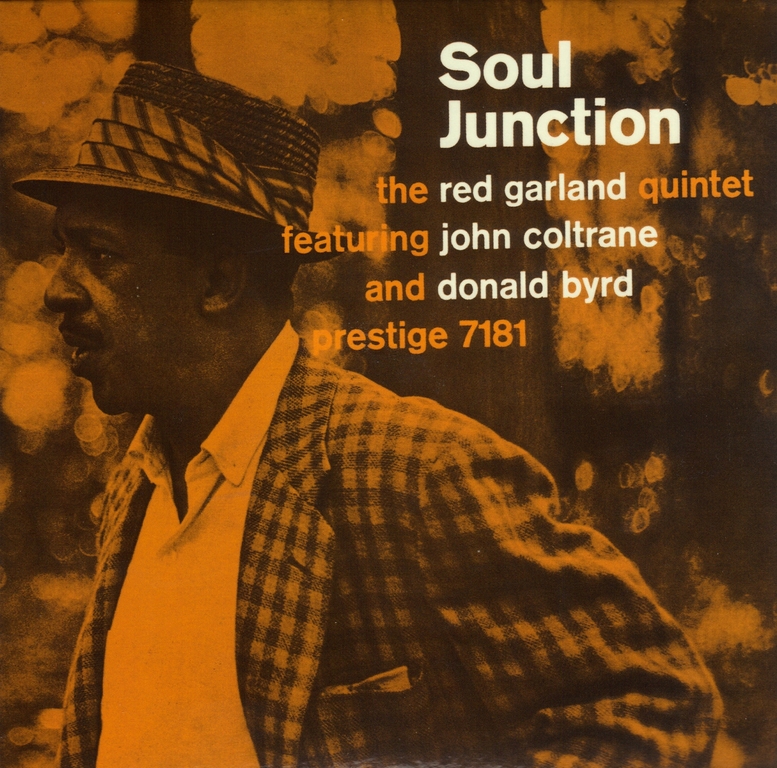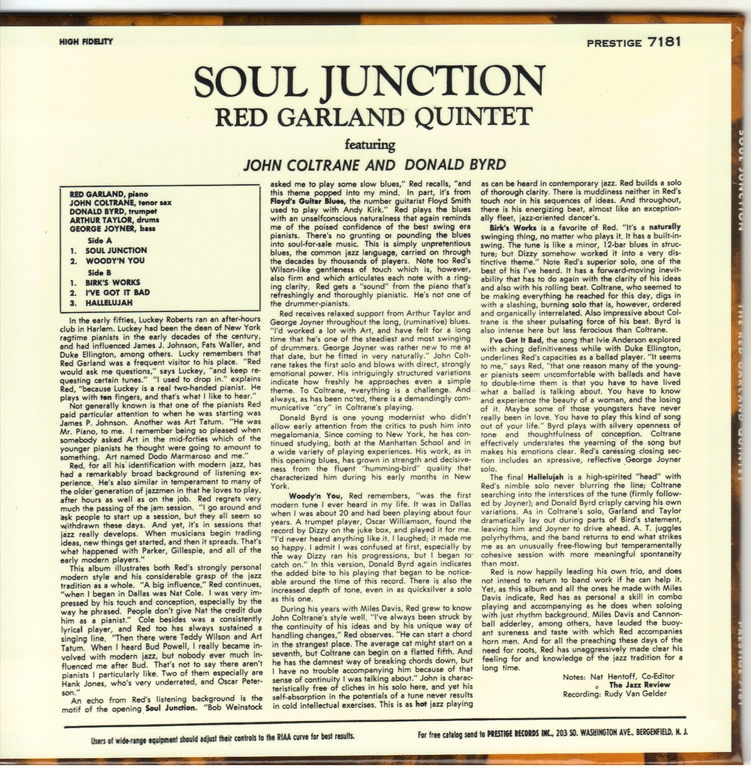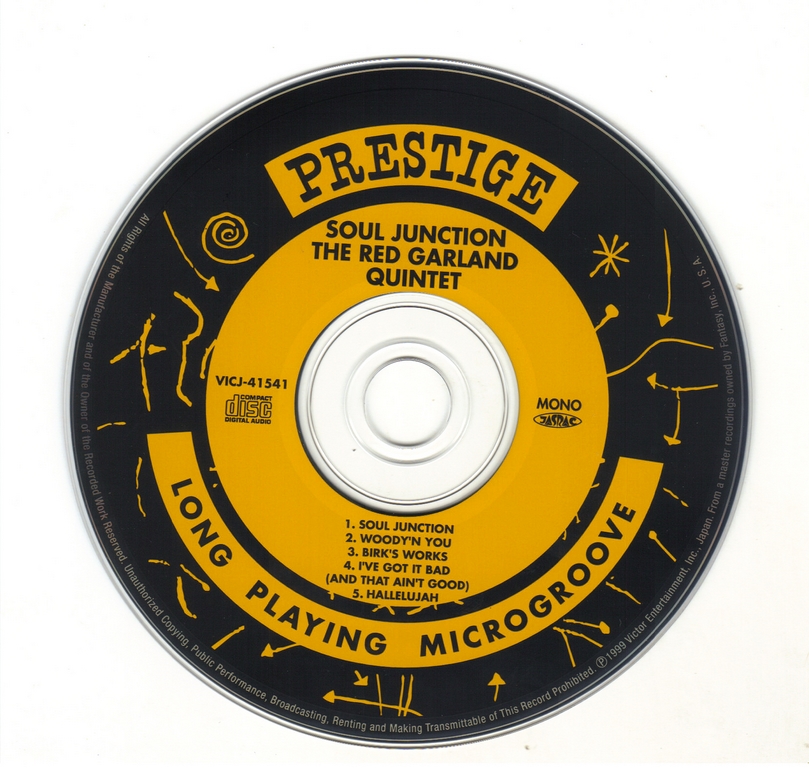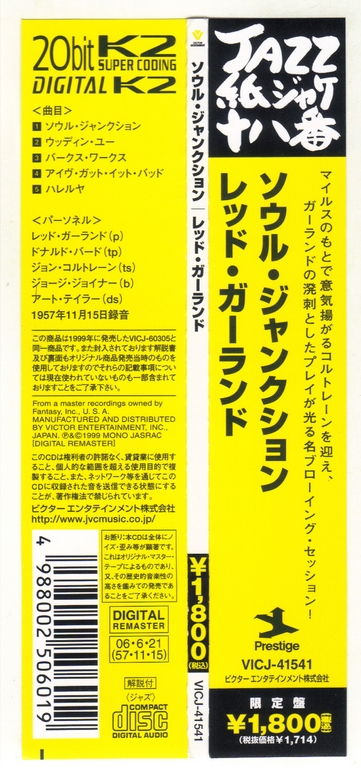



BOOKLET
review by Scott Yanow
Pianist Red Garland’s very relaxed, marathon blues solo on the 16-minute “Soul Junction” is the most memorable aspect of this CD reissue. With such soloists as tenor saxophonist John Coltrane and trumpeter Donald Byrd, plus steady support provided by bassist George Joyner and drummer Art Taylor, Garland gets to stretch out on the title cut and four jazz originals, including “Birk’s Works” and “Hallelujah.” Coltrane is in excellent form, playing several stunning sheets of sound solos.
Red Garland, piano
John Coltrane, tenor saxophone
Donald Byrd, trumpet
Arthur Taylor, drums
George Joyner, bass
Rec: November 15, 1957 by Rudy Van Gelder at Van Gelder Studios, Hackensack, New Jersey.
Remaster 20bit K2, 1999 – MONO
Beginnings
William “Red” Garland was born in Dallas, Texas in 1923. Though he came from a non-musical family, Garland showed an early interest in music. He began his musical studies on the clarinet and alto saxophone but in 1940 switched to the piano. Garland spent copious amounts of time practicing and rapidly developed into a proficient player. A short early career as a welterweight boxer did not seem to hurt his playing hands. He fought a young Sugar Ray Robinson before making the switch to a full-time musician.
Garland’s sound
Garland’s trademark block chord technique, a commonly borrowed maneuver in jazz piano today, was unique and differed from the methods of earlier block chord pioneers such as George Shearing and Milt Buckner. Garland’s block chords were constructed of three notes in the right hand and four notes in the left hand, with the right hand one octave above the left. Garland’s left hand played four note chords that simultaneously beat out the same exact rhythm as the right hand melody played. But, unlike George Shearing’s block chord method, Garland’s left hand chords did not change positions or inversions until the next chord change occurred. It’s also worth noting that Garland’s four note left hand chord voicings occasionally left out the roots of the chords, which later became a chord style associated with pianist Bill Evans. Garland’s block chord method had a brighter quality, slightly more dissonance, and a fullness in the upper register compared to the mellower Shearing block chord sound. Garland’s solo lines also had a glassy, shimmering tone that matched the quality of his chords.[citation needed]
Early work
After the Second World War, Garland performed with Billy Eckstine, Roy Eldridge, Coleman Hawkins, Charlie Parker, and Lester Young. He found steady work in the cities of Boston, New York and Philadelphia. In the late 1940s he toured with Eddie Vinson at the same time that John Coltrane was in Vinson’s band. His creativity and playing ability continued to improve, though he was still somewhat obscure. By the time he became a pianist for Miles Davis he was influenced by Ahmad Jamal and Charlie Parker’s pianist Walter Bishop.[citation needed]
Miles Davis Quintet
Garland became famous in 1955 when he joined the Miles Davis Quintet featuring John Coltrane, Philly Joe Jones and Paul Chambers. Davis was a big fan of boxing and was impressed that Garland had boxed earlier in his life. Together the group recorded their famous Prestige albums, Miles: The New Miles Davis Quintet, Workin, Steamin’, Cookin’, and Relaxin’. Garland’s style is prominent in these seminal recordingsevident in his distinctive chord voicings, his sophisticated accompaniment and his musical references to Ahmad Jamal’s style.[citation needed] Some observers dismissed Garland as a “cocktail” pianist.[4] The quintet’s recordings would arguably influence the Free jazz movement more than some of the more jazz avant-garde records of the time.[citation needed]
Garland played on the first of Davis’s many Columbia recordings, ‘Round About Midnight. Though he would continue playing with Miles, their relationship was beginning to deteriorate. By 1958, Garland and Jones had started to become more erratic in turning up for recordings and gigs. He was eventually fired by Miles, but later returned to play on another jazz classic, Milestones. Davis was displeased when Garland quoted Davis’s much earlier and by then famous solo from “Now’s The Time” in block chords during the slower take of “Straight, No Chaser.” Garland walked out of one of the sessions for Milestones, so that on the track “Sid’s Ahead” Davis comped behind the saxophone solos.
After the Miles Davis Quintet
In 1958 Garland formed his own trio. Among the musicians the trio recorded with are Pepper Adams, Nat Adderley (Cannonball Adderley’s brother), Ray Barretto, Kenny Burrell, Eddie “Lockjaw” Davis, Jimmy Heath, Harold Land, Philly Joe Jones, Blue Mitchell, Ira Sullivan, and Leroy Vinnegar. The trio also recorded as a quintet with John Coltrane and Donald Byrd.[citation needed]
Altogether Garland led 19 recording sessions while at Prestige Records and was involved in 25 sessions for Fantasy Records. He stopped playing professionally for a number of years in the 1960s when the popularity of rock and roll music coincided with a substantial drop in the popularity of jazz.
Garland eventually returned to his native Texas in the 1970s to care for his aged mother. He led a recording in 1977 named Crossings which reunited him with Philly Joe Jones, and he teamed up with world-class bassist Ron Carter. His later work tended to sound more modern and less polished than his better known recordings. He continued recording until his death from a heart attack in April 1984 at the age of 61.
